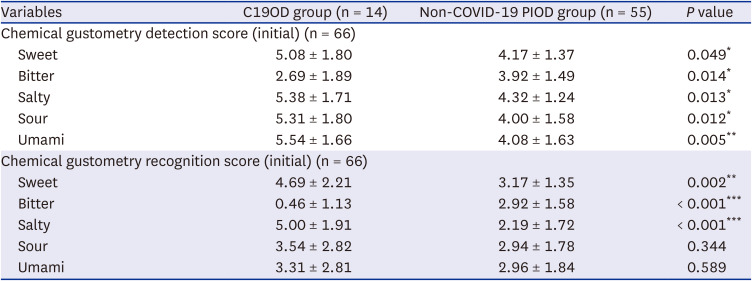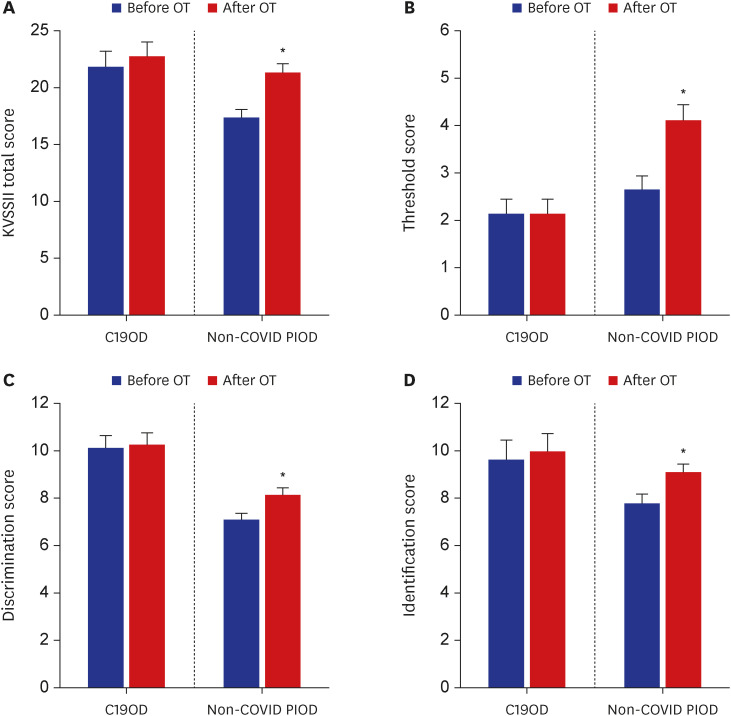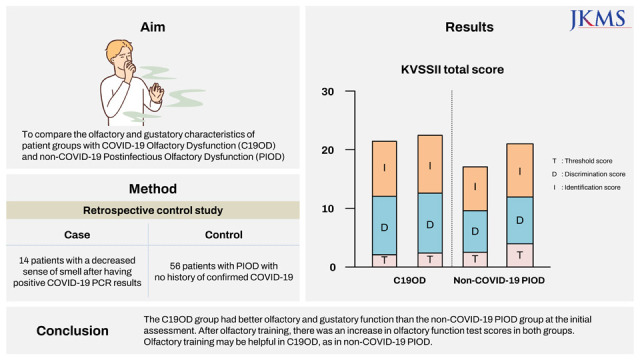1. Tan BKJ, Han R, Zhao JJ, Tan NKW, Quah ESH, Tan CJ, et al. Prognosis and persistence of smell and taste dysfunction in patients with COVID-19: meta-analysis with parametric cure modelling of recovery curves. BMJ. 2022; 378:e069503. PMID:
35896188.

2. Chen L, Zhao J, Peng J, Li X, Deng X, Geng Z, et al. Detection of SARS-CoV-2 in saliva and characterization of oral symptoms in COVID-19 patients. Cell Prolif. 2020; 53(12):e12923. PMID:
33073910.

3. Chen M, Shen W, Rowan NR, Kulaga H, Hillel A, Ramanathan M Jr, et al. Elevated ACE-2 expression in the olfactory neuroepithelium: implications for anosmia and upper respiratory SARS-CoV-2 entry and replication. Eur Respir J. 2020; 56(3):2001948. PMID:
32817004.

4. Wang Z, Zhou J, Marshall B, Rekaya R, Ye K, Liu HX. SARS-CoV-2 receptor
ACE2 Is enriched in a subpopulation of mouse tongue epithelial cells in nongustatory papillae but not in taste buds or embryonic oral epithelium. ACS Pharmacol Transl Sci. 2020; 3(4):749–758. PMID:
32821883.

5. Addison AB, Wong B, Ahmed T, Macchi A, Konstantinidis I, Huart C, et al. Clinical Olfactory Working Group consensus statement on the treatment of postinfectious olfactory dysfunction. J Allergy Clin Immunol. 2021; 147(5):1704–1719. PMID:
33453291.

6. Hummel T, Rissom K, Reden J, Hähner A, Weidenbecher M, Hüttenbrink KB. Effects of olfactory training in patients with olfactory loss. Laryngoscope. 2009; 119(3):496–499. PMID:
19235739.

7. Choi BY, Jeong H, Noh H, Park JY, Cho JH, Kim JK. Effects of olfactory training in patients with postinfectious olfactory dysfunction. Clin Exp Otorhinolaryngol. 2021; 14(1):88–92. PMID:
32575977.

8. Sorokowska A, Drechsler E, Karwowski M, Hummel T. Effects of olfactory training: a meta-analysis. Rhinology. 2017; 55(1):17–26. PMID:
28040824.

9. Park JY, Choi BY, Kim H, Jung T, Kim JK. Olfactory training assists in olfactory recovery after sinonasal surgery. Laryngoscope Investig Otolaryngol. 2022; 7(6):1733–1739.

10. Butowt R, Bilinska K, von Bartheld CS. Olfactory dysfunction in COVID-19: new insights into the underlying mechanisms. Trends Neurosci. 2023; 46(1):75–90. PMID:
36470705.

11. Khan M, Yoo SJ, Clijsters M, Backaert W, Vanstapel A, Speleman K, et al. Visualizing in deceased COVID-19 patients how SARS-CoV-2 attacks the respiratory and olfactory mucosae but spares the olfactory bulb. Cell. 2021; 184(24):5932–5949.e15. PMID:
34798069.

12. Kim JK, Han DH. COVID-19 and smell loss. Korean J Otorhinolaryngol-Head Neck Surg. 2020; 63(11):491–496.

13. Genetzaki S, Tsakiropoulou E, Nikolaidis V, Markou K, Konstantinidis I. Postinfectious olfactory dysfunction: oral steroids and olfactory training versus olfactory training alone: is there any benefit from steroids? ORL J Otorhinolaryngol Relat Spec. 2021; 83(6):387–394. PMID:
34107478.

14. Deems DA, Doty RL, Settle RG, Moore-Gillon V, Shaman P, Mester AF, et al. Smell and taste disorders, a study of 750 patients from the University of Pennsylvania Smell and Taste Center. Arch Otolaryngol Head Neck Surg. 1991; 117(5):519–528. PMID:
2021470.

15. Mott AE, Leopold DA. Disorders in taste and smell. Med Clin North Am. 1991; 75(6):1321–1353. PMID:
1943323.

16. Giacomelli A, Pezzati L, Conti F, Bernacchia D, Siano M, Oreni L, et al. Self-reported olfactory and taste disorders in patients with severe acute respiratory coronavirus 2 infection: a cross-sectional study. Clin Infect Dis. 2020; 71(15):889–890. PMID:
32215618.

17. Haehner A, Draf J, Dräger S, de With K, Hummel T. Predictive value of sudden olfactory loss in the diagnosis of COVID-19. ORL J Otorhinolaryngol Relat Spec. 2020; 82(4):175–180. PMID:
32526759.

18. Izquierdo-Dominguez A, Rojas-Lechuga MJ, Mullol J, Alobid I. Olfactory dysfunction in the COVID-19 outbreak. J Investig Allergol Clin Immunol. 2020; 30(5):317–326.
19. Vandersteen C, Payne M, Dumas LÉ, Cancian É, Plonka A, D’Andréa G, et al. Olfactory training in post-COVID-19 persistent olfactory disorders: value normalization for threshold but not identification. J Clin Med. 2022; 11(12):3275. PMID:
35743346.

20. Heo SJ, Kim TH, Shin SH, Ye MK. Characteristics and prognosis of COVID-19 induced olfactory and gustatory dysfunction in Daegu. Korean J Otorhinolaryngol-Head Neck Surg. 2021; 64(10):720–725.

21. Cattaneo C, Pagliarini E, Mambrini SP, Tortorici E, Mené R, Torlasco C, et al. Changes in smell and taste perception related to COVID-19 infection: a case-control study. Sci Rep. 2022; 12(1):8192. PMID:
35581235.

22. Parma V, Ohla K, Veldhuizen MG, Niv MY, Kelly CE, Bakke AJ, et al. More than smell-COVID-19 is associated with severe impairment of smell, taste, and chemesthesis. Chem Senses. 2020; 45(7):609–622. PMID:
32564071.
23. Asadi MM, Shankayi Z, Bahrami F, Mohammadzadeh T, Amini H, Naderi M. Quantitative analysis of taste disorder in COVID-19 patients, the hypersensitivity to salty quality. New Microbes New Infect. 2021; 43:100919. PMID:
34306710.

24. Hummel T, Lötsch J. Prognostic factors of olfactory dysfunction. Arch Otolaryngol Head Neck Surg. 2010; 136(4):347–351. PMID:
20403850.

25. Lechien JR, Vaira LA, Saussez S. Effectiveness of olfactory training in COVID-19 patients with olfactory dysfunction: a prospective study. Eur Arch Otorhinolaryngol. 2023; 280(3):1255–1263. PMID:
36153785.

26. Kattar N, Do TM, Unis GD, Migneron MR, Thomas AJ, McCoul ED. Olfactory training for postviral olfactory dysfunction: systematic review and meta-analysis. Otolaryngol Head Neck Surg. 2021; 164(2):244–254. PMID:
32660334.

27. Denis F, Septans AL, Periers L, Maillard JM, Legoff F, Gurden H, et al. Olfactory training and visual stimulation assisted by a web application for patients with persistent olfactory dysfunction after SARS-CoV-2 infection: observational study. J Med Internet Res. 2021; 23(5):e29583. PMID:
34003765.
28. Lee Y, Min P, Lee S, Kim SW. Prevalence and duration of acute loss of smell or taste in COVID-19 patients. J Korean Med Sci. 2020; 35(18):e174. PMID:
32383370.

29. Lechien JR, Chiesa-Estomba CM, De Siati DR, Horoi M, Le Bon SD, Rodriguez A, et al. Olfactory and gustatory dysfunctions as a clinical presentation of mild-to-moderate forms of the coronavirus disease (COVID-19): a multicenter European study. Eur Arch Otorhinolaryngol. 2020; 277(8):2251–2261. PMID:
32253535.

30. Prem B, Liu DT, Besser G, Sharma G, Dultinger LE, Hofer SV, et al. Long-lasting olfactory dysfunction in COVID-19 patients. Eur Arch Otorhinolaryngol. 2022; 279(7):3485–3492. PMID:
34757458.












 PDF
PDF Citation
Citation Print
Print





 XML Download
XML Download